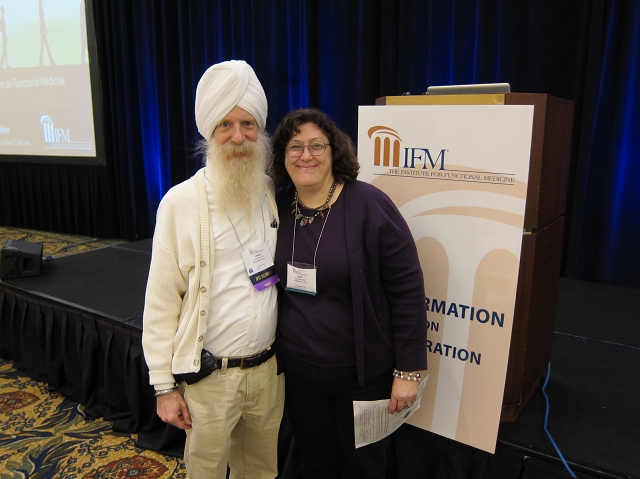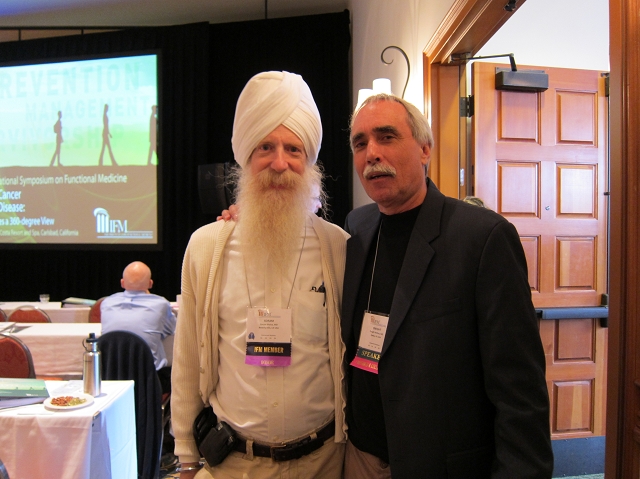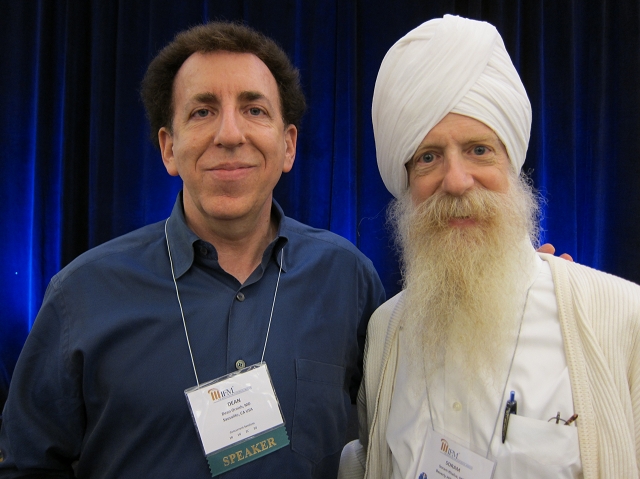Vitamin D again Shown to Protect from Colds and Flus. Are You Getting your Vitamin D This Summer?
June 28, 2010 by Dr. Soram Khalsa
Filed under Vitamin D
Dr James Sabetta and colleagues from Yale University School of Medicine, have published yet another article showing the benefit of vitamin D in protecting against colds and other respiratory infections.
This article which just came out followed almost 200 adults and did monthly vitamin D blood levels on all of the patients from September to early January. The patients were followed for the entire study time for developing upper respiratory infections (common cold or flu).
The findings are completely consistent with what I talk about in my book and here on my blog as well as other articles on Vitamin D and viral infections.
High Prevalence of Vitamin D Deficiency in Pre-Menopausal Women with Breast Cancer
June 24, 2010 by Dr. Soram Khalsa
Filed under Vitamin D
In my book on vitamin D, I discuss the importance of vitamin D as observed from retrospective and epidemiologic studies in helping to prevent breast cancer and the recurrence of breast cancer.
I also mention in my book that as of the date of publication and even to this date I have not seen one breast cancer patient come to my office for immune support as an adjunct to their traditional breast cancer therapy who have had a vitamin D blood level measured by their oncologists.
Now a recently published study by KD Crew and colleagues looked at the frequency of vitamin D deficiency in premenopausal women who were diagnosed with breast cancer and undergoing adjuvant chemotherapy. Adjuvant therapy means therapy that is in addition to the primary chemotherapy that a woman would receive after a diagnosis of breast cancer.
Read more
Canned Foods and BPA
June 20, 2010 by Dr. Soram Khalsa
Filed under Integrative Medicine
 Bisphenol A (BPA) is a common environmental toxin which I have mentioned before, that often appears in plastic bottles. BPA can disrupt the way hormones carry signals in our body and for that reason it is known as a "endocrine disruptor." Because we only need a few hormone molecules to send signals in our bodies, endocrine disruptors are able to interrupt healthy signals at very low concentrations — in fact even a few parts per trillion of BPA has been shown to disrupt normal endocrine signaling that can lead to health problems.
Bisphenol A (BPA) is a common environmental toxin which I have mentioned before, that often appears in plastic bottles. BPA can disrupt the way hormones carry signals in our body and for that reason it is known as a "endocrine disruptor." Because we only need a few hormone molecules to send signals in our bodies, endocrine disruptors are able to interrupt healthy signals at very low concentrations — in fact even a few parts per trillion of BPA has been shown to disrupt normal endocrine signaling that can lead to health problems.
The following are health impacts that have been linked to low level exposure to BPA in either animals or humans:
-Obesity
-Low sperm count
-Damage to developing eggs
-Miscarriage
-Placental cell death
-Infertility
-Heart disease
-Diabetes
-Changes in brain development
-Predisposition to breast and prostate cancer.
A new report called No Silver Lining — An Investigation into Bisphenol A in Canned foods has recently been released by the National Workgroup for Safe Markets which is a coalition of US public health and environmental health focused NGOs.
This report reviews the data on BPA. It points out that Canada,Denmark and five US states have already restricted the use of BPA in certain children's products like baby bottles and infant formula can linings.
In this report that Workgroup was looking at the amount of BPA that could be consumed from eating canned food and drinks that are commonly available in the United States and Canada. For this study they collected and tested the food and beverage contents of 50 cans that were collected from 19 United States and Ontario, Canada.
Read more
Reducing Environmental Cancer Risk-The President’s Report
June 16, 2010 by Dr. Soram Khalsa
Filed under Integrative Medicine
A new report has come out from the President's Cancer Panel which was written by .LaSalle Leffell, Jr.,M.D.,F.A.C.S, and Margaret Kripke Ph.D. The title of the report is Reducing Environmental Cancer Risk — What We Can Do Now.
This report points out that in 2009 approximately 1.5 million American men women and children were diagnosed with cancer and 562,000 died from the disease. Approximately 41% of Americans will be diagnosed with cancer at some point in their lives and approximately 21% will die from cancer.
This report was brought about because of the growing body of evidence that links environmental exposures to cancer. The report points out that the" public is becoming increasingly aware of the unacceptable burden of cancer resulting from environmental and occupational exposures they could have been prevented through appropriate national action."
One of the findings of the panel that particularly concerned them was the finding that the true burden of environmentally induced cancer has been "grossly underestimated". They point out that nearly 80,000 chemicals are on the market in United States that are being used by millions of Americans in their daily lives. These chemicals have either been understudied or unregulated. They point out that one such chemical, BPA, is still found in many consumer products and remains unregulated in our country.
Read more
Reducing Environmental Cancer Risk-The President’s Report
June 16, 2010 by Dr. Soram Khalsa
Filed under Integrative Medicine
A new report has come out from the President's Cancer Panel which was written by .LaSalle Leffell, Jr.,M.D.,F.A.C.S, and Margaret Kripke Ph.D. The title of the report is Reducing Environmental Cancer Risk — What We Can Do Now.
This report points out that in 2009 approximately 1.5 million American men women and children were diagnosed with cancer and 562,000 died from the disease. Approximately 41% of Americans will be diagnosed with cancer at some point in their lives and approximately 21% will die from cancer.
This report was brought about because of the growing body of evidence that links environmental exposures to cancer. The report points out that the" public is becoming increasingly aware of the unacceptable burden of cancer resulting from environmental and occupational exposures they could have been prevented through appropriate national action."
One of the findings of the panel that particularly concerned them was the finding that the true burden of environmentally induced cancer has been "grossly underestimated". They point out that nearly 80,000 chemicals are on the market in United States that are being used by millions of Americans in their daily lives. These chemicals have either been understudied or unregulated. They point out that one such chemical, BPA, is still found in many consumer products and remains unregulated in our country.
Read more
“Solving the Problem of Childhood Obesity Within A Generation”
June 12, 2010 by Dr. Soram Khalsa
Filed under Integrative Medicine
The White House task force on childhood obesity has just released its report to the President entitled "Solving the Problem of Childhood Obesity Within a Generation." This fits in well with Michelle's Obama's cover article in Newsweek recently.
This 120 page report looks at the current epidemic of childhood obesity. Some of the statistics are overwhelming. Currently one in every three child ages to 19 is overweight or obese. Obesity is estimated to cost 112,000 deaths per year in the United States. One third of all children born in the year 2000 are expected to develop diabetes in their lifetime. In addition, a recent article in the New England Journal of Medicine has pointed out that for the first time the current generation of children may be on a course of having a shorter life span than their parents.
There has been a consistent increase in the growth of childhood obesity from 1971 until about the year 2000, at which time childhood obesity levels off.
This very thorough report looks at many aspects of the cause of this epidemic and is full of amazing information. A few of these are
1) Obese adults in current estimated $1429 more in medical expenses than their normal weight years.
2) Medical spending on adults that was attributed just to obesity was over $40 billion in 1998. But in 2008 this had increased to an estimated $147 billion.
3) During childhood excess weight costs an estimated $3 billion per year in direct medical costs.
4) At least $1.6 billion is spent annually on food advertising directed to children and adolescents.
5) 13% of the daily caloric intake for 12 to 19-year-olds now comes from sugar- sweetened beverages.
6) On average, children consumed only 64% of the recommended level of fruit and 46% of the recommended level of vegetables in 2003 to 2004.
7) A mother's preconception weight and weight gain during pregnancy are two of the most important prenatal determinants of childhood obesity. Another way to say this is overweight mothers give birth to overweight children.
8) Maternal smoking girly pregnancy is associated with a 500% greater risk of obesity at age 5.
9) Research shows that it is possible that exposure to endocrine disrupting chemicals during pregnancy play a role in the development of childhood obesity. Scientists have coined the term "obesogins" for chemicals that they believe may promote weight gain and obesity.
10) The Federal Trade Commission (FTC) estimated that in 2006 the food, beverage, and quick serve restaurant companies spent more than $1.6 billion to promote their products to young people.
The statistics in this article go on and on but it is clear that our entire country must change its direction in eating, exercise and focused in order for us to be first the obesity epidemic that we are living with.
The report focuses on five basic things that we can all do together to help this epidemic:
1) Create a healthy start on life for our children, from pregnancy through early childhood;
2) Empower parents and caregivers to make healthy choices for their families;
3) Serve healthier foods in schools;
4) Ensure access to healthy, affordable food;
5) Increase opportunities for physical activity.
I encourage you to read the whole article which can be gotten at this website.
Let me know what you think. Do you talk to your overweight friends about diet and exercise? What do you think can be done to improve this obesity epidemic?
"Solving the Problem of Childhood Obesity Within A Generation"
June 12, 2010 by Dr. Soram Khalsa
Filed under Integrative Medicine
The White House task force on childhood obesity has just released its report to the President entitled "Solving the Problem of Childhood Obesity Within a Generation." This fits in well with Michelle's Obama's cover article in Newsweek recently.
This 120 page report looks at the current epidemic of childhood obesity. Some of the statistics are overwhelming. Currently one in every three child ages to 19 is overweight or obese. Obesity is estimated to cost 112,000 deaths per year in the United States. One third of all children born in the year 2000 are expected to develop diabetes in their lifetime. In addition, a recent article in the New England Journal of Medicine has pointed out that for the first time the current generation of children may be on a course of having a shorter life span than their parents.
There has been a consistent increase in the growth of childhood obesity from 1971 until about the year 2000, at which time childhood obesity levels off.
This very thorough report looks at many aspects of the cause of this epidemic and is full of amazing information. A few of these are
1) Obese adults in current estimated $1429 more in medical expenses than their normal weight years.
2) Medical spending on adults that was attributed just to obesity was over $40 billion in 1998. But in 2008 this had increased to an estimated $147 billion.
3) During childhood excess weight costs an estimated $3 billion per year in direct medical costs.
4) At least $1.6 billion is spent annually on food advertising directed to children and adolescents.
5) 13% of the daily caloric intake for 12 to 19-year-olds now comes from sugar- sweetened beverages.
6) On average, children consumed only 64% of the recommended level of fruit and 46% of the recommended level of vegetables in 2003 to 2004.
7) A mother's preconception weight and weight gain during pregnancy are two of the most important prenatal determinants of childhood obesity. Another way to say this is overweight mothers give birth to overweight children.
8) Maternal smoking girly pregnancy is associated with a 500% greater risk of obesity at age 5.
9) Research shows that it is possible that exposure to endocrine disrupting chemicals during pregnancy play a role in the development of childhood obesity. Scientists have coined the term "obesogins" for chemicals that they believe may promote weight gain and obesity.
10) The Federal Trade Commission (FTC) estimated that in 2006 the food, beverage, and quick serve restaurant companies spent more than $1.6 billion to promote their products to young people.
The statistics in this article go on and on but it is clear that our entire country must change its direction in eating, exercise and focused in order for us to be first the obesity epidemic that we are living with.
The report focuses on five basic things that we can all do together to help this epidemic:
1) Create a healthy start on life for our children, from pregnancy through early childhood;
2) Empower parents and caregivers to make healthy choices for their families;
3) Serve healthier foods in schools;
4) Ensure access to healthy, affordable food;
5) Increase opportunities for physical activity.
I encourage you to read the whole article which can be gotten at this website.
Let me know what you think. Do you talk to your overweight friends about diet and exercise? What do you think can be done to improve this obesity epidemic?
“Confronting Cancer as a Chronic Disease”- The IFM Convention
June 8, 2010 by Dr. Soram Khalsa
Filed under What's Dr Soram Doing?

I am just recently back from the Institute for Functional Medicine (IFM) convention in Carlsbad, California. The subject of this year's symposium was "Confronting Cancer as a Chronic Disease: Primary Care Taking a 360-degree View."
In all, 21 countries were represented and attendance was sold out at 600 people.
I have been a member of the Institute for Functional Medicine since its inception. It was created by my longtime friend and colleague Dr. Jeffrey Bland.
The 4 day conference had a full schedule with lectures starting at 7 AM and closing around 6:30 PM every night.
Even though I have attended so many other IFM conventions, this is probably the best one I have ever attended. All aspects of integrative oncology were discussed. Lectures on the role of antioxidants in cancer prevention and treatment were part of the conference. Other topics were nutritional and botanical support during cancer therapy, individualizing nutrition protocols to complement Cancer care, and using biomarkers for primary prevention in secondary recurrence of common cancers.
The conference was organized by my friends Mary Hardy, M.D. and Dwight McKee, M.D, Ph.D. Dwight and I attended medical school together and were friends throughout school.

Dr Soram with Mary Hardy, M.D.

Dr Soram with Dwight McKee, M.D. Ph.D
Two of the most prominent speakers were Dr. Dean Ornish, and Dr Keith Block. Dr Ornish gave a lecture entitled "The Power of Sustainable Changes in Diet and Lifestyle". Dr. Ornish has carried over his amazing findings on diet and lifestyle for the benefit of heart disease and is now using it to benefit cancer patients. You can pick up his new book by clicking HERE.
Dr. Ornish was also the recipient of the Linus Pauling Person of the Year award, given for his work showing the benefit of diet and lifestyle for chronic disease. I was delighted to learn during his lecture that he was a student of Swami Muktananda, who was very good friends with my teacher Yogi Bhajan, and I was able to share a few words with Dr. Ornish about our teachers, and have a photograph taken with him and at the end of his speech.

Dr Soram with Dean Ornish, M.D.
Dr. Keith Block gave an information packed lecture entitled "Long-Term Biologic Strategies for Ssecondary Prevention of Cancer". Dr Block has written a great book explaining his approach to integrative oncology. You can pick it up HERE.
Some of the lectures were very medically detailed. However, many were understandable by lay people and I wish some of my cancer patients had been able to attend some of these wonderful lectures and learn. In any case I am bringing back to my practice all the exciting new information about using integrative medicine for cancer patients. For those of you who would like to get a sample of these lectures, I am delighted to say that Jeffrey Bland's opening talk entitled "Looking Anew at Cancer" is available online for free by clicking this link.
I have already shared some of the new information from this convention in my blog and I look forward to sharing much more over the weeks ahead with all my readers.
“Confronting Cancer as a Chronic Disease”- The IFM Convention
June 8, 2010 by Dr. Soram Khalsa
Filed under What's Dr Soram Doing?

I am just recently back from the Institute for Functional Medicine (IFM) convention in Carlsbad, California. The subject of this year's symposium was "Confronting Cancer as a Chronic Disease: Primary Care Taking a 360-degree View."
In all, 21 countries were represented and attendance was sold out at 600 people.
I have been a member of the Institute for Functional Medicine since its inception. It was created by my longtime friend and colleague Dr. Jeffrey Bland.
The 4 day conference had a full schedule with lectures starting at 7 AM and closing around 6:30 PM every night.
Even though I have attended so many other IFM conventions, this is probably the best one I have ever attended. All aspects of integrative oncology were discussed. Lectures on the role of antioxidants in cancer prevention and treatment were part of the conference. Other topics were nutritional and botanical support during cancer therapy, individualizing nutrition protocols to complement Cancer care, and using biomarkers for primary prevention in secondary recurrence of common cancers.
The conference was organized by my friends Mary Hardy, M.D. and Dwight McKee, M.D, Ph.D. Dwight and I attended medical school together and were friends throughout school.

Dr Soram with Mary Hardy, M.D.

Dr Soram with Dwight McKee, M.D. Ph.D
Two of the most prominent speakers were Dr. Dean Ornish, and Dr Keith Block. Dr Ornish gave a lecture entitled "The Power of Sustainable Changes in Diet and Lifestyle". Dr. Ornish has carried over his amazing findings on diet and lifestyle for the benefit of heart disease and is now using it to benefit cancer patients. You can pick up his new book by clicking HERE.
Dr. Ornish was also the recipient of the Linus Pauling Person of the Year award, given for his work showing the benefit of diet and lifestyle for chronic disease. I was delighted to learn during his lecture that he was a student of Swami Muktananda, who was very good friends with my teacher Yogi Bhajan, and I was able to share a few words with Dr. Ornish about our teachers, and have a photograph taken with him and at the end of his speech.

Dr Soram with Dean Ornish, M.D.
Dr. Keith Block gave an information packed lecture entitled "Long-Term Biologic Strategies for Ssecondary Prevention of Cancer". Dr Block has written a great book explaining his approach to integrative oncology. You can pick it up HERE.
Some of the lectures were very medically detailed. However, many were understandable by lay people and I wish some of my cancer patients had been able to attend some of these wonderful lectures and learn. In any case I am bringing back to my practice all the exciting new information about using integrative medicine for cancer patients. For those of you who would like to get a sample of these lectures, I am delighted to say that Jeffrey Bland's opening talk entitled "Looking Anew at Cancer" is available online for free by clicking this link.
I have already shared some of the new information from this convention in my blog and I look forward to sharing much more over the weeks ahead with all my readers.
Vitamin K and A New Theory of Chronic Degenerative Disease
June 5, 2010 by Dr. Soram Khalsa
Filed under Featured, Integrative Medicine
 Dr. Bruce Ames has been one of the brightest minds over the last decades in the world of biochemical nutrition. He is now in his 80s and for the last years, he has been writing about his theory of the development of chronic degenerative disease, which he calls "Triage Theory".
Dr. Bruce Ames has been one of the brightest minds over the last decades in the world of biochemical nutrition. He is now in his 80s and for the last years, he has been writing about his theory of the development of chronic degenerative disease, which he calls "Triage Theory".
In a new article by Dr Ames and his colleague, Joyce McCann, the authors discuss this new theory. This theory is based on the question "Is micronutrient inadequacy linked to diseases of aging"? Micronutrients include everything from zinc and selenium to vitamin D and vitamin K, all of which we get in small quantities in our diet.
In this article, they specifically look at vitamin K. What they propose is that when our body has a limited amount of a given nutrient e.g. vitamin K, it shunts the nutrient to the biochemical processes that are most needed for immediate survival. The theory is that when there is not enough of the nutrient over many years, other biochemical processes that are important, but which do not lead to an acute problem, do not receive a sufficient amount of the nutrient over a long period of time. This insufficiency does not produce immediate problems. But what this theory says is that this long term deficiency of the nutrient neededfor these other essential biochemical processes leads to chronic degenerative diseases, rather than an acute medical problem.
In this article they specifically look at vitamin K. Vitamin K's immediate use is to allow our blood to coagulate. So if you only have a small amount of vitamin K it will be used primarily to allow your blood to coagulate so you do not bleed to death. However what they point out in this study, is that long-term relative deficiency of vitamin K is linked to several age associated conditions. These include bone fragility after menopause, and arterial calcification which is linked to cardiovascular disease. Also in animal models an increased incidence in cancer has been observed in long term vitamin K deficiency.
This theory is completely compatible with Dr. Robert Heaney's concept of "long latency deficiency diseases" which is discussed extensively in my book on vitamin D. In the case of vitamin D, an immediate deficiency will lead to rickets. However from all the research, it appears that a long term low-level deficiency of vitamin D leads to increased risk for cancer, heart disease, diabetes high blood pressure, osteoporosis etc.
I really like this theory! Whether we call it "triage theory" or "long latency deficiency disease theory," this concept makes enormous sense to me. The profound changes I have seen in my own practice of medicine as well as in my own health, from optimizing vitamin D levels, has shown me that vitamin D in higher levels bestows many additional benefits besides the prevention of rickets. It makes total sense to me that our current epidemic of chronic diseases and fast food, can be linked to a relative insufficiency of many of the micronutrients that we all will get if we eat a healthy diet.
I have attempted to explain these complex concepts in a way that is understandable for you my readers. Please let me know if you have questions? Please let me know what your thoughts are on these concepts? I look forward to hearing back from you.


